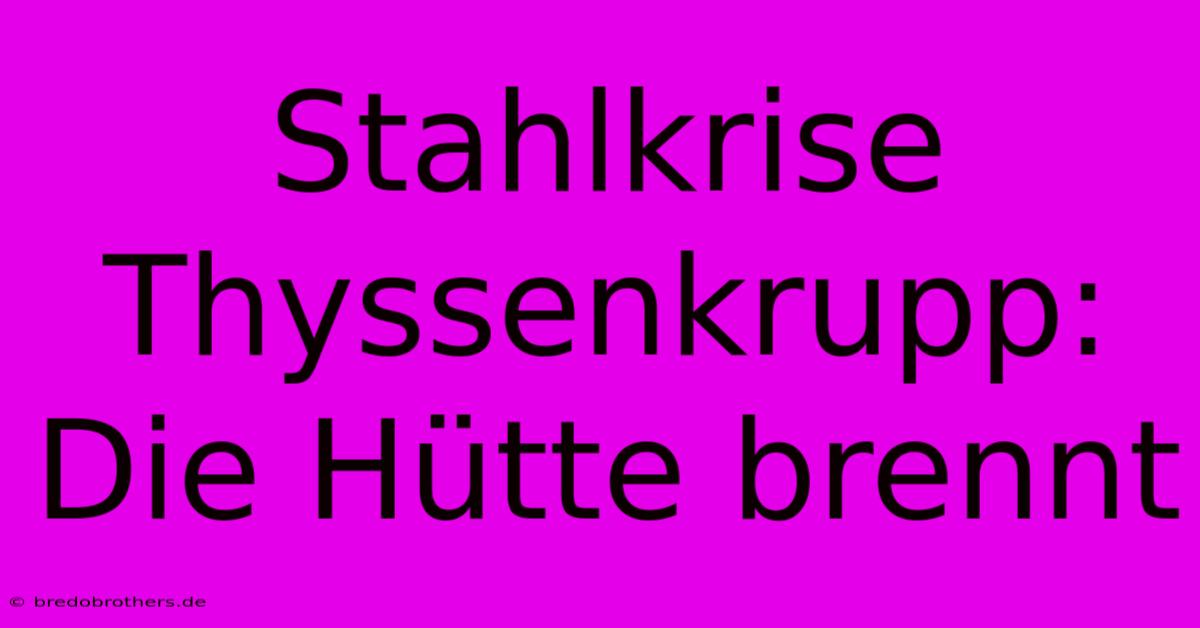Stahlkrise Thyssenkrupp: Die Hütte Brennt

Discover more detailed and exciting information on our website. Click the link below to start your adventure: Visit Best Website Stahlkrise Thyssenkrupp: Die Hütte Brennt. Don't miss out!
Table of Contents
Stahlkrise Thyssenkrupp: Die Hütte brennt – Ein Insiderbericht
Hey Leute! Let's talk about Thyssenkrupp, specifically the massive steel crisis they've been facing. Man, it's been a wild ride, and I've got some stories to tell you. I've been following this closely, partly because my uncle worked for them for years – he's a real steel guy, knows the industry inside and out. So I've picked up a thing or two, let me tell you.
Die Anfangszeit: Wo ging es schief?
Remember a few years back? Things seemed rosy for Thyssenkrupp, right? Big plans, mergers, acquisitions… the works. But then, bam. The global steel market took a nosedive. Demand plummeted. Suddenly, everyone was feeling the pinch. My uncle, bless his heart, was telling me about the rising costs – energy prices skyrocketing, raw materials becoming scarce… it was a perfect storm.
And it wasn't just the global market. Internal struggles played a part too. They were juggling so many different divisions, so many different projects. It felt like they were trying to be everything to everyone, and in the end, they were spread too thin. It's like trying to juggle chainsaws and flaming torches – not a recipe for success, trust me.
Die Auswirkungen: Arbeitsplätze und Zukunft
The consequences were brutal. Plant closures. Job losses. Entire communities impacted. My uncle nearly lost his job. He had to work overtime, retrain for a different role, and even take a pay cut to stay afloat. It was stressful, to say the least, and he’s a strong guy!
The human cost is immense. This isn't just about balance sheets and profit margins; it's about real people and their families. It’s a reminder of the very real impact of economic downturns on individuals and society. The social impact can last for generations, people losing their homes, their sense of belonging. It's heartbreaking.
Was kann man tun? Hoffnung und Perspektiven
So, what's the future look like? Honestly, it's complicated. Thyssenkrupp is trying to restructure, to focus on more profitable areas. They're investing in new technologies, trying to become more efficient. But it's a long road.
There's a lot of talk about sustainability and green steel. This is crucial for the future of the industry. Companies that embrace sustainable practices will be better positioned for long-term success. This means reducing carbon emissions, developing new recycling methods, and exploring alternative steel production processes.
But this transition requires huge investments and a serious commitment to change. It won't happen overnight. The German government also has a huge role to play in supporting the industry through this transition. We need policies that encourage investment in green technologies and support workers affected by the restructuring.
Persönliche Lernerfahrungen: Was ich mitgenommen habe
This whole experience has taught me a lot. It's shown me the fragility of even the biggest companies and the importance of adaptability and resilience. Diversification is key, spreading your risk across different markets and sectors. Ignoring the warnings of a changing market can be devastating, and it's something to avoid.
Watching my uncle navigate this crisis has been tough, but he’s shown me the power of perseverance. He’s learned to diversify his skills, which is something we all should consider. Even in tough times, focusing on adapting and learning new skills can make all the difference.
The Thyssenkrupp crisis is a reminder of the complex challenges facing the steel industry. It's a story of struggles, but also of resilience and adaptation. Let's hope they can navigate this difficult period and emerge stronger on the other side. It won't be easy, but it's certainly possible.

Thank you for visiting our website wich cover about Stahlkrise Thyssenkrupp: Die Hütte Brennt. We hope the information provided has been useful to you. Feel free to contact us if you have any questions or need further assistance. See you next time and dont miss to bookmark.
Featured Posts
-
Bootunglueck Aegypten Sea Story Kentert
Nov 26, 2024
-
Tauchbootkatastrophe Rotes Meer Deutsche Opfer
Nov 26, 2024
-
Nfl Harbaugh Bruderduell
Nov 26, 2024
-
Bootsunglueck Rotes Meer Suche Nach 17
Nov 26, 2024
-
Starke Performance Pierer Mobility Aktie
Nov 26, 2024
